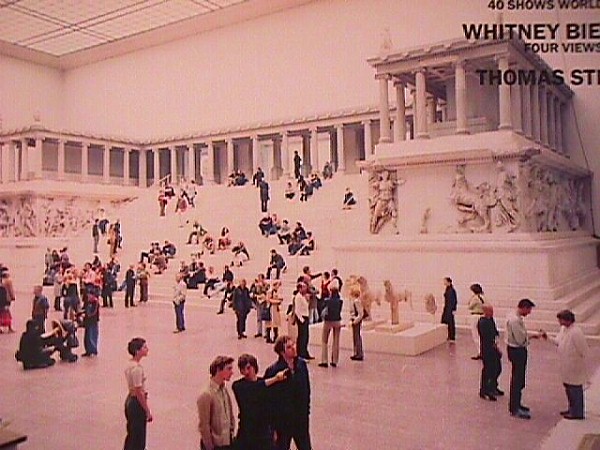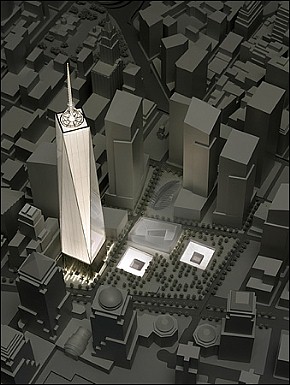2000.08.09
the new Quondam
...tapping into the "virtual's" greater potential, that being the ability to create something completely other in all respects. It's like the more unreal I make Quondam, the more something really other it becomes.
2000.09.08 13:12
thanks, I
I like the notion of Quondam being a virtual place in architectural history because that's exactly what it is, and, more than likely, always will be.
2001.01.15
denial
The point is that today not all architectures are buildings. This is not to deny the real world, rather to recognize the notion that architecture, by architects, now has further options of being designed without the usual physical means.
I repeat, the new architecture of cyberspace does not replace real world architecture. If the implication is not clear, I then add that the new architecture of cyberspace does not deny real world architecture either.
In the several times I have brought up this issue within various venues, there is always the counter argument of an "either-or" attitude. Is it really that difficult to grasp that cyberspace offers a new, addition realm within which architects can design places? I use the notion of 'place' because the notion of a virtual building is only one type of cyber place.
I can well remember back in 1983 when I first learned and professionally utilized CAD, specifically the many, many professional colleagues (both in offices and academics) that saw no place within the field of architecture for computers and cad. That's the type of denial I was referring to.
2001.01.16
virtual architecture
I agree whole-heartedly that cyberspace offers a "parallel" realm within which to design and 'build'. The term I've used instead of parallel is 'other', as in the best architecture in cyberspace is something other than the architecture of the real world. I too am not interested in seeing the architecture of cyberspace merely being a reenactment of the real world. The real world of architecture already does an excellent job of reenacting itself.
What you say about amazon.com being mostly akin to catalogue shopping is true, but there is still more to amazon in that the catalogue is hypersized, and that many of the additional services such as automatic recommendations of similar products and free out-of-print book searches make for good usability. You didn't say anything about eBay, however, which is much more 'other' than the heretofore traditional auction house.
Oddly, I've never read Neuromancer, but that might be because when the book was published (1984) I was already well immersed in Intergraph 2D and 3D cad--drawing and designing in cyberspace was already a fact for me then, and definitely not a fiction. (Should I read the book now?)
| |
2001.01.25
AD[vocating] PUBLICITY
Virtual architecture can be many things, and not necessarily something facilitated by the internet. Virtual architecture that is facilitated by the internet, however, should reasonably utilize whatever the internet has to offer. There can be representation and there can be presentation. Virtual architecture can represent the world as we know it or it can present something other than the world as we know it. Personally, I think it more challenging and design-wise more stimulating to use virtual architecture facilitated by the internet to try presenting something other than what is already available.
Because I focused on creating an 'other than what is already there' museum I learned that collecting and exhibiting digital data only begets more and more and more digital data, i.e., I found myself with a[n architectural] collection that is virtually infinite. This virtual infinite characteristic comes from the intrinsic mutable nature of digital data. As an architect, I now see a virtual architecture challenge in now trying to design a virtual museum [of] architecture that matches the virtual infinity of its collection.
2001.07.22
the architecture of being [fog]
...that Quondam is still a virtual museum of architecture, but more specifically a museum of architecture that engenders the virtual.
2002.05.26 15:27
Re: Virtual Architecture and Art?
Computers seem to have a lot to do with virtual architecture, most likely because of the new drawing dexterity that computers provide architects. Beyond that, however, computers/CAD enable whole new visualizations of architecture. I am not so much interested in creating virtual environments, as much as environments parallel to real-time/place reality. For example, designing and (virtually) building an addition to Le Corbusier's Villa Savoye, or imagining oneself as an architect-as-squatter within Louis Kahn's Hurva Synagogue. In the sense of creating a whole other history of architecture parallel to the real present.

2002.05.27 18:52
real/virtual existence
On this month's (May 2002) cover of the magazine Artforum is a picture of the Altar of Zeus from Pergamon as it is presently in the Pergamon Museum in Berlin. Not only is this architecture that has moved, but the (now over a century old) installation is a true example of the composite of the real and the virtual. A whole new virtual Temple has been reconstructed utilizing fragment remains of the original--a part real, part virtual building in a sense, or is it now a part Greek, part German building? For sure it is a mostly virtual building within a real building. It is also a part real, part reenactment building within a real building.
| |
2002.05.28 10:47
Re: virtual buildings
In terms of virtual buildings (like Quondam) online, the building has to first come to you before you can go through it. Granted the visitor to a virtual building first sends a request for the virtual building to come. That's the way the Internet works right now--you can't go into a website until the website data comes to you. Relativeness is not the issue as much as inversion is.
Could it be that the more extreme a situation is, the less relative it is?
or
Could it be that the more extreme a situation is the more it begins to invert itself?
2002.05.31 14:58
High, Low, or No Rise?
It doesn't seem realistic to put virtual architecture in the category of superficial aesthetic architectures. Virtual buildings (like Quondam) do not even exist as buildings in the real world, thus lack all aesthetics that might overshadow environmental and/or political needs. Indeed, virtual buildings could be considered very environmental since they do not disturb the existing natural or man-made environment at all. Architects should begin the understand that virtual buildings can at times be a viable alternative to real buildings, especially if the virtual building can do the same job (and perhaps even a better job) than a real building--eBay is a perfect example.
I already made my thoughts on this clear within an interview conducted by Brian Carroll in June, 1999. Seeing Koolhaas make almost exactly the same statements a year later in a Wired magazine article (June 2000), indicates that I'm either just slightly ahead of the trends, or that Koolhaas takes other peoples/architects ideas and then lets the world assume the ideas are his own. Maybe Koolhaas used to visit the virtual building Quondam.
Strange how terrorists are probably the greatest users of virtual buildings so far.
2003.05.15 13:59
Re: Life in a real museum
Metabolism as a physiological function operates via equal measures of destruction and creation, i.e., catabolism and anabolism. The metabolic is a visceral destructive/creative human process.
Perhaps Venice should be reenacted like the caves with primitive painting in them. Make the original off limits and allow the tourists to visit the facsimile.
2003.09.07 12:26
Re: perfectly symmetrical circles
The way I see it, the reality of virtual symmetry is its asymmetry.
2003.11.15 13:50
Re: Is it the end of theory?
The 'theory' that I utilize most now-a-days in terms of guiding/informing my design actions centers on the notion that the virtual realm is an 'other' place to work within as an architect and/or artist. The virtual realm (whose infrastructure is now largely the Internet and the general wired-ness of our planet) is a place additional/optional to the real realm. Although many current theories (and realities) see the real and the virtual merging in our daily lives, I more enjoy investigating the virtual realm in its more extreme position (which exists regardless of whether or not there is concurrent merging of the real and virtual going on).
| |
2003.11.21 16:24
Re: Virtual and Real
Quondam - A Virtual Museum of Architecture celebrates its 7th anniversary online today.
The weather in Philadelphia today is gorgeous, and I was going to visit the closest real museum to me--Ryerss Museum and Library--to look at a pieces of the Coliseum and the Great Wall and even the full contents of a Japanese Buddhist Temple. The Ryerss Mansion is a wonderful example of a house that morphed into a museum, and the contents of the museum are all the things that the last residents of the Ryerss Mansion purchased about 100 years ago as they traveled around the world, particularly through the Orient. For a couple of years now I like to refer to the Ryerss Museum as a "Museum of Someone's [Global] Shopping." I didn't make it to Ryerss, though, because my trip to the bank, the post office (sending things to eBay shoppers in New York and Italy), and the supply store took longer than expected. I might go to Ryerss tomorrow or Sunday, however.
2003.11.21 17:00
virtual guggenheim?
The Virtual Guggenheim is so beyond virtual that it's actually not there.
2004.05.10 15:17
Re: ducked around ?
"Imaginative history" is a kind of virtual reality, is it not?
As much as I see the virtual domain as something other, there nonetheless remains the wide held notion that the distinction between the real and the virtual is increasingly blurred in our times.
Reenactment is a kind of "imaginative history", is it not?
2005.06.29 11:47
GZ eyeballed {intermission}

This image, from today's New York Times, is the clearest image I've seen thus far to indicate where the redesign process presently is. Admittedly, I really haven't been (visually) following the process over the last few years, but, for some reason, now I get it, meaning I understand where everything (planned) is. In a strange way, this image is almost like looking down from the top of one of the lost WTC towers itself. It was seeing St. Paul's Church at this angle that reminded me of seeing the church from a similar angle when I was last atop the WTC (early September 1990). Just now I'm thinking of what might be an interesting virtual memorial--utilizing a 3D model of the greater NY/NJ area, a "visitor" would be positioned where the quondam WTC observation deck used to be, and from there he or she could direct their gaze taking in the views that once were.
|